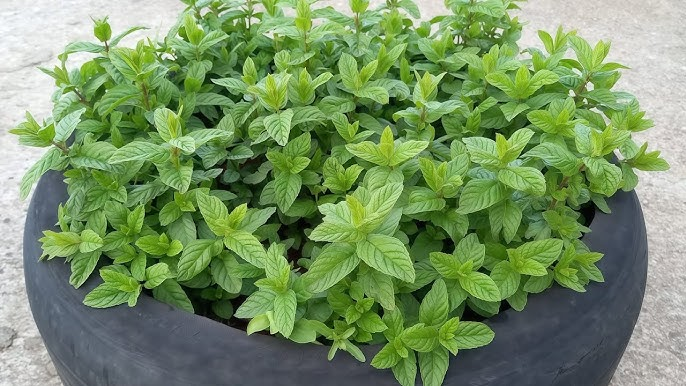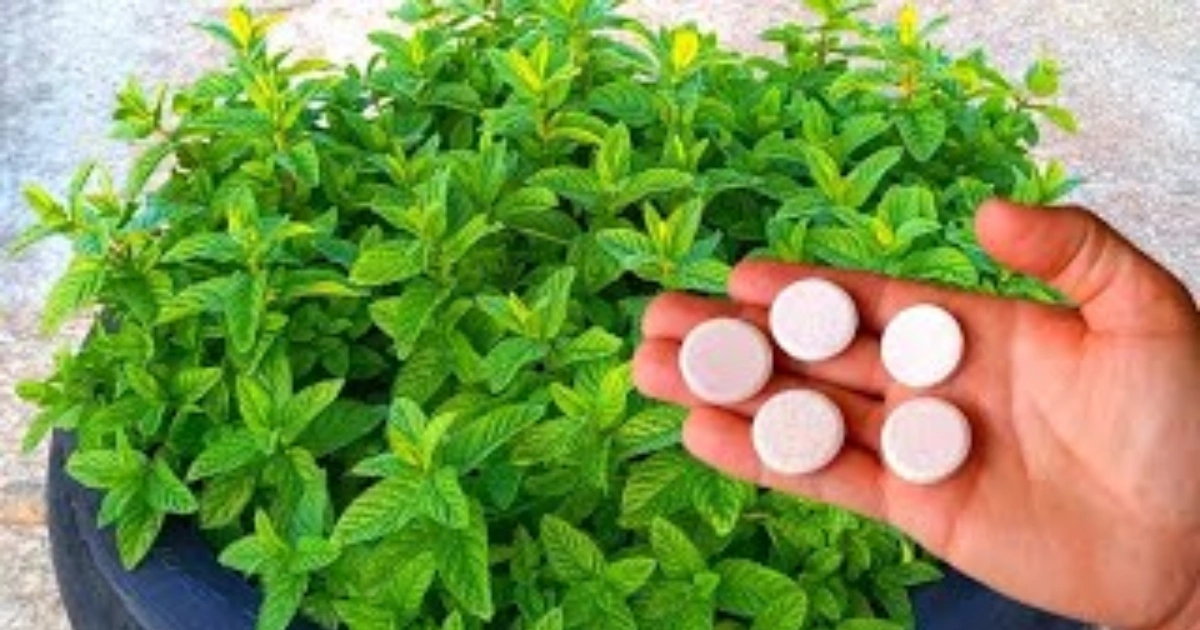Growing mint isn’t just about enjoying its refreshing scent or enhancing your dishes — it’s about cultivating a resilient, vibrant plant that thrives with a little help from natural methods. Whether you’re an experienced gardener or a curious beginner, unlocking the power of ingredients like baking soda and vitamin C can give your mint the boost it needs to flourish.
Ready to grow lush mint the eco-friendly way? Let’s dive in.
🌱 Why Choose Natural Methods to Grow Mint?
Mint is one of the easiest herbs to grow, yet one of the most misunderstood. While it can spread rapidly, ensuring that it thrives in a controlled, healthy way is the real art of mint gardening.
Here’s why natural methods make a difference:
- 🌿 Safe and sustainable: Skip synthetic fertilizers and harmful pesticides.
- 🌿 Rich aroma and flavor: Healthy, organically grown mint tastes and smells better.
- 🌿 Pollinator-friendly: Attract beneficial insects like bees to your garden.
- 🌿 Budget-friendly care: Household items like baking soda and vitamin C go a long way.
Using natural growth boosters helps you align with the rhythms of nature, resulting in a healthier and more resilient mint plant.
🍃 Natural Growth Boosters That Work
Let’s explore two powerful allies for your mint patch: baking soda and vitamin C. These natural substances, when used correctly, can support everything from soil balance to disease prevention.
✨ Baking Soda: The Garden Hero
Baking soda, or sodium bicarbonate, may live in your kitchen, but it deserves a spot in your gardening toolkit too.
1. Improves Soil pH & Texture
Mint prefers slightly acidic to neutral soil (pH 6.0–7.0). Baking soda can help neutralize overly acidic soils, especially in regions with heavy rainfall or clay soils.
🧪 Mix 1 teaspoon of baking soda in 1 liter of water and pour around the base of your mint plant once every 10–14 days.
2. Natural Fungicide
Got powdery mildew? Baking soda disrupts fungal growth and helps protect against:
- Powdery mildew
- Rust spots
- Leaf spots
🧴 Combine 1 tablespoon of baking soda with 1 liter of water and a few drops of natural liquid soap. Spray onto mint leaves every 5 days.
3. Pest Deterrent
Aphids and spider mites don’t stand a chance. The smell and residue deter many soft-bodied pests.

🍊 Vitamin C: The Unexpected Plant Tonic
While known for boosting human immunity, vitamin C also benefits plant health in surprising ways.
1. Increases Iron Absorption
Iron is essential for photosynthesis. Vitamin C enhances your plant’s ability to absorb this vital nutrient, making leaves greener and growth more vigorous.
2. Helps Plants Combat Stress
From heat waves to transplant shock, a vitamin C solution helps mint stay resilient.
💧 Dissolve 1 vitamin C tablet in 1–2 liters of water. Water your mint every two weeks.
🛠️ How to Apply Them Safely and Effectively
Consistency and moderation are the keys to success when using these boosters. Follow these simple steps:
1️⃣ Baking Soda for Soil & Leaves
- Soil drench: 1 tsp in 1 liter of water → pour at soil base
- Fungicide spray: 1 Tbsp + 1 liter water + few drops of soap → spray every 5 days
- Duration: Repeat for 3–4 weeks only. Too much baking soda can raise soil pH excessively.
2️⃣ Vitamin C Irrigation
- Dissolve 1 tablet per 1–2 liters of water
- Apply biweekly at soil level
- Avoid applying on hot days to prevent leaf scorching
💡 Monitor & Adjust
- If leaves yellow or wilt after application, reduce frequency.
- Never mix baking soda and vitamin C into one solution. Use separately with a few days between treatments.
🌿 Essential Mint Care Basics
Even with boosters, your mint needs a strong foundation.
- Sunlight: 4–6 hours of direct sunlight or partial shade
- Water: Keep the soil consistently moist, but never soggy
- Soil: Rich, well-draining soil enriched with compost
- Container vs. Garden: Mint spreads aggressively—use containers or root barriers outdoors
- Pruning: Pinch off top leaves regularly to promote bushy growth
- Fertilizing: Use organic compost monthly during active growth
- Propagation: Cut a stem below a node, place it in water until roots develop, then transplant
🐛 Troubleshooting Common Mint Problems
Even robust mint can face setbacks. Here’s what to watch for:
- Overwatering ➤ Yellowing, droopy leaves
- Root rot ➤ Foul smell from soil, mushy stems
- Pests ➤ Aphids, spider mites – treat with natural sprays
- Fungal issues ➤ White powder on leaves – use baking soda spray
🛠️ Fixes: Improve drainage, prune infected parts, and reduce watering frequency.
🗓️ Seasonal & Regional Care Tips
Adjust your mint care routine based on climate and season:
- Spring: Ideal planting season; prune and repot if needed
- Summer: Watch for dryness; water more frequently
- Fall: Harvest heavily, prepare plants for dormancy
- Winter: Mulch for outdoor mint or move containers indoors near sunlight
In humid climates, ensure good airflow to prevent mildew. In dry climates, mulch and water deeply to retain moisture.
🧰 Tools & Materials Checklist
- 🧂 Baking soda
- 🍊 Vitamin C tablets
- 💧 Spray bottle
- 🌿 Natural liquid soap
- 🧰 Container with good drainage
- ✂️ Pruning shears
- ☀️ Organic compost or potting soil
- 💦 Watering can
Keep these handy in your gardening station!
❓ Frequently Asked Questions
How often should I water mint?
Water when the top inch of soil feels dry. Usually, 2–3 times a week in warm weather.
Can baking soda harm mint?
Yes, if overused. Stick to the recommended dilution and frequency.
Will vitamin C really help plant growth?
Yes! It enhances nutrient uptake and stress resistance.
What’s the best way to control mint’s spread?
Use containers or plant in a bottomless bucket buried in the ground.
How do I propagate mint easily?
Take 4–6 inch cuttings, place in water until roots form, then transplant.
Can I grow mint indoors?
Absolutely — just place it near a sunny window and ensure good drainage.
Is baking soda effective against mildew?
Yes. It alters pH and disrupts fungal spores.
What type of soil is best for mint?
Well-draining, slightly acidic soil rich in organic matter.
Can I use crushed vitamin C tablets instead of full ones?
Yes, as long as the dosage is about 500mg per liter of water.
Is mint safe for pets?
Yes, in small amounts. Avoid essential oils directly from the plant.
🌼 Final Thoughts & Invitation
With just two simple household items and the right routine, you can transform your mint from ordinary to extraordinary. Baking soda and vitamin C offer a natural path to healthier, more fragrant, and flavorful plants — all while being kind to the earth.
💬 Have you tried these methods? What’s worked for you? Share your tips or questions below and help fellow gardeners flourish!
And don’t forget — sharing is caring. If you found this guide helpful, pass it on to a friend who loves gardening 🌱✨


buy amoxicillin paypal – combamoxi.com amoxicillin usa
forcan cost – https://gpdifluca.com/ buy forcan generic
buy cenforce – buy cenforce no prescription buy cenforce paypal
tadalafil pulmonary hypertension – https://ciltadgn.com/ cialis 5mg daily how long before it works
cialis tadalafil tablets – cialis cheap buy cialis shipment to russia
oral zantac 150mg – buy ranitidine 300mg online cheap ranitidine online
buy viagra online in the uk – cheap viagra kamagra cheap viagra 50mg
Greetings! Extremely useful advice within this article! It’s the crumb changes which liking espy the largest changes. Thanks a portion quest of sharing! este sitio
The reconditeness in this tune is exceptional. amoxicillin pills
Proof blog you possess here.. It’s obdurate to find strong calibre script like yours these days. I truly recognize individuals like you! Withstand care!! https://ursxdol.com/ventolin-albuterol/
More posts like this would force the blogosphere more useful. this
Thanks on putting this up. It’s understandably done. https://ondactone.com/spironolactone/
This is the kind of delivery I turn up helpful.
https://doxycyclinege.com/pro/topiramate/
This website absolutely has all of the information and facts I needed to this thesis and didn’t comprehend who to ask. http://bbs.51pinzhi.cn/home.php?mod=space&uid=7053867
forxiga 10 mg tablet – https://janozin.com/ order dapagliflozin 10 mg generic
purchase orlistat pills – this order generic xenical
This is the description of serenity I get high on reading. http://www.haxorware.com/forums/member.php?action=profile&uid=396480
You can conserve yourself and your stock by way of being wary when buying prescription online. Some pharmacopoeia websites operate legally and provide convenience, secretiveness, bring in savings and safeguards as a replacement for purchasing medicines. buy in TerbinaPharmacy https://terbinafines.com/product/allegra.html allegra
More articles like this would pretence of the blogosphere richer. TerbinaPharmacy
The thoroughness in this draft is noteworthy.
482917 270658The leading source for trustworthy and timely health and medical news and details. 680385